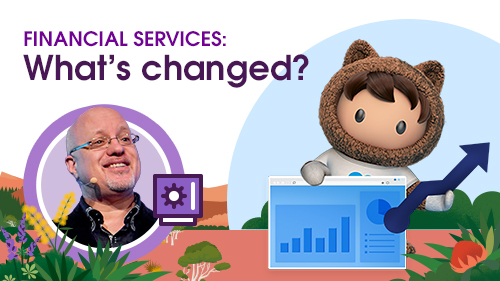Has the Financial Services Industry Changed for the Better?



Back in mid-2020, futurist Brett King shared his thoughts on how digital transformations brought on by COVID-19 would affect financial services. Ahead of his appearance in the Financial Services Episode at Salesforce Live: Australia & New Zealand on 30 March, we asked him to share what’s happened with financial services since, and how technology is creating change in the industry.
This past year has resulted in some major changes to the ways we live, work and play, not least of which is that digital became the primary conduit through which businesses – of all sizes, all shapes and all industries – engaged with customers, clients, stakeholders and employees.
Financial services was no different. Back in the middle of 2020, I reflected on how COVID-19 pushed digital transformation within financial services past the point of no return. Financial services has traditionally been a slow industry to adapt to change. However, the past year has shown that when push comes to shove, financial services organisations need to adapt to the new ways of doing business.
Probably the biggest shift was that, with a few exceptions, everything moved online. If businesses didn’t have a strong digital presence at the start of 2020, they definitely have one now. Customers also have new preferences for engaging with businesses online, and high expectations about the kinds of experiences they’ll have while doing so.
This acceleration of digital activity posed some challenges for financial services businesses, while exposing opportunities for others that had already been innovating. For example, incumbents that previously prioritised face-to-face interactions to build relationships had to quickly find new ways to engage with customers remotely. And customers’ needs changed as many people looked to develop a relationship with banks and other financial services that went beyond just day-to-day transactions.
The future ecosystem will be made up of surviving incumbent banks, tech players and fintech companies that can capitalise on these changes. Technology has been, and will continue to be, a huge driver of this shift. The majority of interactions people now have with financial services businesses are done through the technology layer: it’s tech first, and banking second.
This digital transformation will only continue to accelerate. Customers are more digitally competent than ever, empowered by more choices and with reduced tolerance for subpar digital experiences.
It’s imperative that financial services institutions become absolutely obsessive about keeping these new customer needs and expectations at the centre of everything. However, while technology is causing this disruption, it’s also providing endless opportunities for creativity, engagement, service and innovation in banking and insurance.
These shifts and what they mean for the future of financial services are what I’ll be focusing on during my appearance in the upcoming Salesforce LIVE: A&NZ Financial Services Episode (which you can register for here). To help prepare, I thought I would share some of the biggest changes I’m seeing in financial services, and my predictions for how these will affect the future of the industry.
Partnerships for success
We no longer live in a world where one supplier ticks all the boxes, and going forward there will be more interplay between banks and tech companies. There are advantages to financial services companies playing off each other’s strengths in order to find the best solutions.
For banks, working with a fintech has advantages. They can usually work faster, cheaper, have more space to innovate and test new ideas with less risk.
For fintechs, partnerships or collaborations with established players also have benefits. They understand the regulatory environment, they have a large pool of resources at their disposal, and they can often lean on brand reputation.
For many organisations, this will take a cultural shift, but those that can use partnerships to efficiently and rapidly bring in new offerings or create new services will have a real advantage in the future.
It’s all about the data
Another big trend affecting financial services is this push for more and more personalised experiences, and getting the right message to the right people at the right time. One of the biggest enablers of personalisation is data.
The industry has made strides in real-time engagement through apps and instant banking, which generates really useful historical data. But it’s been hard for some institutions to translate this information into predictive insights, and to get the data they need to really be proactive about addressing customer needs.
Take for example home loans. If you’re a provider of home loans, the number one most important piece of information to know is a person’s intent to buy a home. Right now, financial institutions don’t have that information. They wait for a customer to come to them inquiring about loan services. In the future, waiting for this to happen won’t be enough.
Google has this data, because it knows search histories and can see who is looking up house prices or listings. Apple will have this data because people are using real estate apps on their phones. Partnerships, like what I talked about earlier in this piece, can really help here because these types of organisations will act as gatekeepers to provide financial services companies with this data.
This is just one example of how you can use data to contextualise the banking experience for customers and anticipate what the customer needs and when. And those partnerships – tapping into existing data sources and leveraging relationships to access relevant data – will become critical. However, it’s paramount that the financial services industry maintains trust in their services. Everything needs to be transparent and conform to the highest of standards.
More value for money
If I had to wrap all of these future trends into one word, I would say the future of financial services is ‘smart’. This means that the financial services industry needs to use digitisation to create more value for customers by adding smartness to their operations.
This means evolving from simply facilitating transactions to serving as a financial coach and partner in their pocket. It’s moving on from a customer’s card being declined while paying for groceries; instead, geolocation information will know they’ve entered a grocery store, their previous use history will know their average spend on groceries, and they will receive an alert saying they need to transfer money to their account – or the money might even be transferred automatically.
This is the type of contextualisation and smartness people are hungry for. Particularly coming off the stress of the pandemic, people are looking for security, support and help with achieving their financial goals. It’s imperative that the financial services industry uses the digital acceleration of the past year to offer more value to their customers and get ahead of the curve.
What are your thoughts on where the future of financial services is heading?
Salesforce Live:
Australia & New Zealand
All Episodes on Demand























